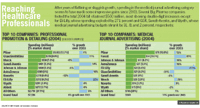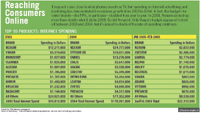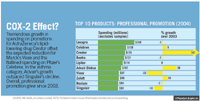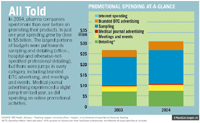Media Spend Trends: Changing Lanes
Pharmaceutical Executive
Direct-to-consumer spending increased from $3.2 billion to almost $4.1 billion between 2003 and 2004, the biggest leap since the category began in 1997. While other US industries are just getting their footing back after a prolonged economic slump, DTC advertising, as in previous years, seems unaffected and continues to thrive. Even in the wake of FDA's virtual shutdown of the lucrative COX-2 inhibitor market, both DTC and professional promotional spending have, so far, remained in tact. (See "TV Dominates")
Direct-to-consumer spending increased from $3.2 billion to almost $4.1 billion between 2003 and 2004, the biggest leap since the category began in 1997. While other US industries are just getting their footing back after a prolonged economic slump, DTC advertising, as in previous years, seems unaffected and continues to thrive. Even in the wake of FDA's virtual shutdown of the lucrative COX-2 inhibitor market, both DTC and professional promotional spending have, so far, remained in tact. (See "TV Dominates")

Jay Bolling
"[Spending] keeps going up, in part, because it works," says Elizabeth Boehm, a senior analyst with Forrester Research's healthcare and life sciences group. Deep pharma pockets help, too. "When you have a relatively open budget, you can spend more on a product."
Given the industry's historic aversion to knee-jerk reactions, it may be too early to judge the effect, if any, the COX-2 fiasco will have on consumer and professional promotion dollars. Pfizer's Celebrex (celecoxib) and Bextra (valdecoxib) and Merck's Vioxx (rofecoxib) were three of the top 10 products in US professional promotional spending in 2004, according to IMS Health. Overall, COX-2 inhibitors were the third-leading therapeutic class in professional spend dollars. However, Boehm predicts the COX-2 shakeup will have little effect on promotional spend levels overall.
"Pain medicines are not necessarily the driving force of promotional spending," she says. "There's always going to be a new drug to promote. In the beginning the big thing was allergy medications, now, I think, the next big category will be the statins."

TV Dominates
Following several years of sluggish growth, journal ad spending grew 11 percent between 2003 and 2004, according to Kathleen Henderson, senior vice president and general manager of PERQ/HCI. Much of this growth, she says, was fueled by ads for psychotherapeutics (antidepressants), neurological products (anti-migraine, Alzheimer's therapies) and cardiovascular (cholesterol-reducing) drugs. Spending in allergy journals fell 46 percent as several popular allergy medications switched to OTC status. But this bump in journal ad spending, warns Henderson, doesn't necessarily mean professional journals showed a period of healthy ad growth across the board. (See "Reaching Healthcare Professionals" )
"Although several journal types, such as psychology, neurology, pain management, and cardiology have double-digit increases, the market as a whole is only up modestly," Henderson says. "This is due in large part to the fact that several of the new products that are advertising heavily do not place a lot of space in primary care publications, as they are targeted more to specialists."

Sue Ramspacher
Henderson notes this is a change from the early-to-mid nineties, when many new cardiovascular products were advertised to primary care doctors as well as to specialists.
From the company perspective, Henderson says, Pfizer has already scaled back its journal ad spending in first quarter of 2005, compared to the same time period in 2004, putting Forest in the lead. "Pfizer needs to save some money and deal with some legal issues," Henderson says.
Certainly, Pfizer is not the only company that is considering reworking its communications spend. Patrick Burns, principal for San Diego-based BW Analytics, a firm that specializes in pharma return-on-investment strategies, says, "Historically, the most effectiveness in promotional dollars has been realized in the field sales force. But as an industry, we're getting close to filling the waiting rooms with more sales reps than patients."

Reaching Healthcaren Professionals
To prevent this, Burns cautions clients not to ramp up their field sales forces when they enter a new market and then lay them off later. "The smarter strategy," he says, "is to look at the existing field force, track their activities along with other promotional channels, and do mid-course adjustments as needed."
In particular, Burns says, the practice of sampling is due for an adjustment. This is a hotly debated topic because the cost of doling out drug samples to physicians can't, in fairness, be measured in retail sale value. Nonetheless, it's still an enormous expense. "For decades, samples have primarily been an access tool for the sales rep to get face time with healthcare providers," Burns says. "But some pharma companies have over-invested in samples to the point that doctors are writing less prescriptions because their sample closets are stuffed."

David Gascoigne
That type of ROI analysis is characteristic of what smart marketers are doing at drug companies. They are undertaking a critical, tactical analysis of a promotional effort's overall impact on drug sales. "They're not just looking at the effect of detailing and sampling on their own," says Burns. They're looking for cohesion between their direct-to-physician and DTC activities and what can be done to maximize those dollars."
That learning curve has been underway for the last few years. What's still left to be understood, however, is how pharma marketers should grow those integrated efforts into more holistic healthcare messages, the kind that the industry's stakeholders are demanding.
The Self-Care Shift
Almost all analysts interviewed see 2005 as a bridge to a new era of promotion. They predict a shift, rather than a reduction, in total drug promotion spend in 2005 and beyond.

Reaching Consumers Online
"In twelve to eighteen months you'll see a greater push toward drug adherence marketing," Boehm says, "especially among the statins like AstraZeneca's Crestor (rosuvastatin), Merck's Zocor (simvastin) and Pfizer's Lipitor (atorvastatin)." Keeping consumers on these medications is a challenge that is landing squarely in marketers' laps. One industry study, Boehm says, indicates 50 percent of patients on these cholesterol-busters stop taking them after six months; 60 percent are off-the-statin-wagon in 12.
"There's lots of reasons why this happens," she says, ranging from the economic to the physical. "Marketers will begin experimenting on how to get people to stay on their drugs; it's not straightforward or clear how to do that."
Catching Interest, Resisting Involvement
Although marketers may struggle with keeping patients on treatment, there are signs they're getting better at generating initial, pre-prescription interest. TV continues to be the crown jewel of this effort, with DTC ad awareness levels jumping from 69 to 89 percent between 2003 and 2004. Sue Ramspacher, senior vice president of NOP World Health, says TV's triumph is directly related to a "dramatic spend" by marketers in this medium. Spending rose from $1.9 billion in 2003 to $2.6 billion in 2004.
"In early 2004 you couldn't turn on the TV without seeing ads for the newest erectile dysfunction drugs, and the COX-2 wars were still going on," Ramspacher says.

Patrick Burns
"Believability" of DTC ads, according to Ramspacher, rose to 57 percent across all media channels, as did "likeability," which rose to 66 percent in categories like asthma.
In spite of this good news, she says DTC promotion is still preaching to the choir rather than gathering new converts: "DTC primarily influences patients who are already diagnosed and are being treated, but fails to motivate the undiagnosed and untreated who represent more than 50 percent of sufferers in many large categories."
Such was the case with Eli Lilly's osteoporosis medication, Evista (raloxifene), according to Jay Bolling, managing partner of Roska Direct. "We had a well-defined audience, but the product was not on their radar screen," says Bolling. "Women would see an ad for Evista and think of their mother, not of themselves. In cases like this, you're dealing with issues of apathy and denial."

Elizabeth Boehm
Bolling and his team launched an ad campaign in women's books which included a consumer response vehicle that wove together product and disease awareness information. It offered a 30-day free trial offer for Evista to women who redeemed a certificate included in the mail-in response.
Moving Right Along
There are various reasons why people who would benefit from a prescription resist taking it.
"Some people may be suffering but, whether they be internal beliefs or barriers, don't think they're ready for a medication," Ramspacher says. "When these people see a branded prescription drug ad, they ignore it because they're not seeing themselves in them. This speaks to the need for pharmaceutical marketers to better balance their branded message ads and their unbranded disease awareness ads." Some companies are already experimenting with this more subtle awareness-to-adoption mix and are reaping early successes.
Consumers may rush straight to the doctor after seeing a drug ad, but they are rushing to the computer to find out more. NOP figures suggest that the Internet is becoming the "intermediary" between doctors and patients; nearly one-third of those who contacted their doctors after seeing a DTC ad first went to the web to find out more. (See "Reaching Consumers Online.")

COX-2 Effect?
As the relatively new field of DTC advertising matures, it is becoming increasingly clear to marketers that effective consumer messages operate on a continuum of action; it's up to them to prod consumers almost every step of the way. Indeed, even if a consumer is motivated enough to go to their doctor and get a prescription, 25 percent never make it to the pharmacy. "Getting to the doctor is one thing, taking a drug is another," Boehm quips.
"Marketers need more comprehensive communication programs," Ramspacher says. "They have advertising that prompts a patient to go see their doctor, and most of the time the doctor will give them what they ask for. But they're losing them somewhere between the doctor and the pharmacy. This may be an opportunity for advertisers to make sure they have a synergistic disease campaign which reinforces the need to fill the prescription by using other media channels."
Web-based reminders offer pharma marketers a fast and thrifty connection to consumers. "Behavior is a difficult thing to change," Boehm says. "The Internet offers a low-cost option for lifestyle support when a condition requires diet and exercise changes in addition to drug therapy."

All Told
Outside Influences
One goal has reigned supreme for pharmaceutical marketers since the dawn of DTC eight years ago—the quest for the greatest return-on-investment. David Gascoigne, practice leader of promotion management at IMS Management Consulting, says ROI is improving. Sixty-four brands Gascoigne studied in 2004 showed a median DTC ROI increase of $2.20 for each $1.00 invested. Twelve of those brands boasted ROI in excess of $4.50 for each $1.00 spent, although seven took a loss.
But Gascoigne cautions that managed care practices may chip into these gains. "It's more difficult to drive ROI for certain brands and markets with increasing managed care influence," Gascoigne says, whose research shows a direct correlation between higher "out-of-pocket" prescription costs and lower return on DTC ROI. To get consumers to dig into their own pockets for a drug, he suggests, ads must be that much more convincing.
"DTC is not just for the big players and becomes a key driver of brand performance, particularly in more consumer-driven markets and specialty markets," he says. "It can be a key part of the marketing mix for brands with little or no third-party coverage." Some forward thinking managed care organizations, however, may be starting to see the wisdom in footing the bill for newer, higher-priced drugs if viewed as an investment instead of a perk.
"A lot of employers do look at their healthcare expenditures and perceive that their drug spending is higher than other categories, but some are beginning to see this may head off higher healthcare costs for members down the road," says Boehm.
But Gascoigne says the success of a DTC campaign isn't measured simply on the rate of ROI and, like analysts Boehm and Ramspacher, urges savvy pharma marketers to create a better mix of brand-specific and more general public relations efforts for their brands. "The ROI for PR is almost double the level of [that for] DTC," he says.
Continuing hostility from activists who say too much is spent on promotion and not enough on R&D might affect DTC spending. The Washington Legal Foundation, for example, called for the Department of Justice to move its FDA-based promotion investigations from its consumer to criminal division in March. Burns, however, doesn't see these efforts affecting promotional spending.
"Some activists and regulators say if drug companies took half of the money from their promotional efforts and spent it on clinical research it would make drugs more affordable," he says. "But the fundamental economics are absent, because pharma companies know their competitors won't do it. So long as we're driven by capitalism, we will see drug companies spending in proportion to what they've been doing all along."
Other factors that may potentially impact DTC spending are the rising number of brand-name drugs that will become generic in the next few years and the addition of 29 million people to Medicare's drug benefit rolls in 2006. But these aren't really seen by any of the analysts as affecting promotional spending, either.
"I don't believe drug advertising is going to stall," Ramspacher says, "but we will see a greater amount spent on unbranded disease awareness campaigns and corporate reputation ads. There will be a shift and redirection, as opposed to an elimination or reduction, in promotional spending."
Diane West is a freelance writer covering healthcare and issues facing the pharmaceutical industry. She can be reached at wordsworthnyc@aol.com

The Misinformation Maze: Navigating Public Health in the Digital Age
March 11th 2025Jennifer Butler, chief commercial officer of Pleio, discusses misinformation's threat to public health, where patients are turning for trustworthy health information, the industry's pivot to peer-to-patient strategies to educate patients, and more.
Navigating Distrust: Pharma in the Age of Social Media
February 18th 2025Ian Baer, Founder and CEO of Sooth, discusses how the growing distrust in social media will impact industry marketing strategies and the relationships between pharmaceutical companies and the patients they aim to serve. He also explains dark social, how to combat misinformation, closing the trust gap, and more.